| Srl | Item |
| 1 |
ID:
108254
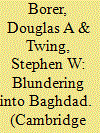

|
|
|
|
|
| Publication |
2011.
|
| Summary/Abstract |
Some postmortems of the Bush Administration's pre-Iraq war decision-making have focused on a dysfunctional National Security Council (NSC) structure as the major reason for the lack of a thorough strategic assessment prior to the March 2003 invasion. Other academic and journalistic accounts have focused on a lack of a first rate conceptual thinker at the top levels of the Bush Administration as an important cause of the strategic shortcomings in Iraq decision-making. This article will assess the relative impact of decision-making structure versus quality of strategic leadership in explaining poor performance in the first five years of the Iraq war.
|
|
|
|
|
|
|
|
|
|
|
|
|
|
|
|
| 2 |
ID:
119438
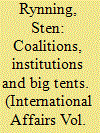

|
|
|
|
|
| Publication |
2013.
|
| Summary/Abstract |
Armed interventions of the past decades demonstrate that strategic leadership can give way to lofty campaign plans, conflicting strategic narratives and concern with tactical, as opposed to strategic, issues. The intervention debate rightfully emphasizes the need for both leadership and institution-building to rectify this situation, but then breaks down into discord: some critics argue that stronger leadership by big nations is necessary, others that this type of leadership wrecks the collective institutions that are needed in a new age of multilateralism and interdependence.
This article argues instead that strategic leadership grows out of the effort to connect the three distinct political arenas that have come to dominate armed interventions: coalitions, institutions and big tent diplomacy. Strategic leadership is not about choosing between coalitions or institutions; it is about building bridges among these political arenas.
The article embeds this argument within the strategic literature and demonstrates how it emerges from an engagement with modern armed interventions. It engages in two in-depth assessments of NATO's experiences in Afghanistan and Libya and then undertakes a more general discussion of the steps that can be taken to encourage strategic leadership.
|
|
|
|
|
|
|
|
|
|
|
|
|
|
|
|
| 3 |
ID:
130678
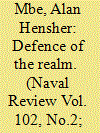

|
|
|
| 4 |
ID:
139092
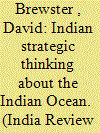

|
|
|
|
|
| Summary/Abstract |
It is sometimes claimed that India has ambitions to become the leading power in the Indian Ocean. This article examines the different streams of Indian strategic thinking about the Indian Ocean and how they will likely contribute to future Indian strategic behavior. It argues that although many among its elite aspire for India to eventually become the leading power in the Indian Ocean, there is little conceptualization as to what India needs to do to achieve this. For several reasons, including an attachment to ideas of non-alignment and strategic autonomy, Indian strategic behavior in the Indian Ocean will likely continue to be relatively reactive and constrained.
|
|
|
|
|
|
|
|
|
|
|
|
|
|
|
|
| 5 |
ID:
154087


|
|
|
|
|
| Summary/Abstract |
We face a world in which geopolitical and geo-economic risks are multiplying. Most of West Asia is ablaze, stoking speculation that a long Sunni-Shia war (like Europe’s Thirty Years’ War between Catholics and Protestants) could be at hand. China’s rise is fuelling a wide range of territorial disputes in Asia and challenging America’s strategic leadership in the region. And Russia’s invasion of Ukraine has apparently become a semi-frozen conflict, but one that could reignite at any time.
|
|
|
|
|
|
|
|
|
|
|
|
|
|
|
|
| 6 |
ID:
121975
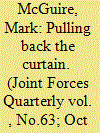

|
|
|
| 7 |
ID:
032958
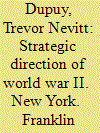

|
|
|
|
|
| Publication |
New York, Franklin Watts, Inc., 1965.
|
| Description |
65p.Hbk
|
| Series |
Military History of World War II
|
| Contents |
Vol. XVIII
|
|
|
|
|
|
|
|
|
|
|
|
Copies: C:1/I:0,R:0,Q:0
Circulation
| Accession# | Call# | Current Location | Status | Policy | Location |
| 008110 | 940.54/DUP 008110 | Main | On Shelf | General | |
|
|
|
|
| 8 |
ID:
070611


|
|
|
| 9 |
ID:
058015


|
|
|
| 10 |
ID:
133780
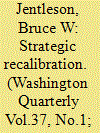

|
|
|
|
|
| Publication |
2014.
|
| Summary/Abstract |
The release of the Obama administration's 2014 National Security Strategy comes amidst increasing criticism of its strategic savvy. Some are rank partisan, some Monday-morning quarterbacking. Some, though, reflect the intensifying debate over the optimal U.S. foreign policy strategy for our contemporary era.
At one end of the debate are those advocating retrenchment, who see limited global threats on one hand and prioritize domestic concerns on the other-be they the budget-cutting of the Tea Party right or the nation-building-at-home of the progressive left. At the other end are neoconservatives and others pushing for re-assertiveness. This is based on a bullish assessment of U.S. power and the contention that it still is both in the U.S. national interest and that of world order for the United States to be the dominant nation. While retrenchment overestimates the extent to which the United States can stand apart, re-assertiveness overestimates the extent to which it can sit atop.
|
|
|
|
|
|
|
|
|
|
|
|
|
|
|
|
| 11 |
ID:
133410
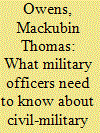

|
|
|
|
|
| Publication |
2012.
|
| Summary/Abstract |
It is a great honor and pleasure to return to the US Air Force Academy today. It is also a great honor to be associated with the name of Ira Eaker, a true American hero and one of the fathers of American air power. I'm sure by this time you have seen Twelve O'clock High, and I assure that if you haven't, you WILL see it in the future. You may know that Major General Patrick Pritchard, the character played by the actor Millard Mitchell, is based on Ira Eaker. When we use the movie at the Naval War College, we focus on Pritchard as an example of strategic leadership-linking the tactical and the operational levels of war to national policy. This is what Ira Eaker did: he was responsible for proving the feasibility of daylight precision bombing as an operational concept linked to national policy. Someday many of you will be expected to provide this same strategic bridge between operational art on the one hand and national policy on the other.
|
|
|
|
|
|
|
|
|
|
|
|
|
|
|
|